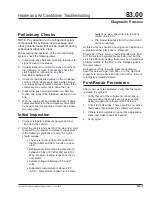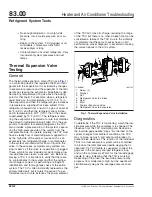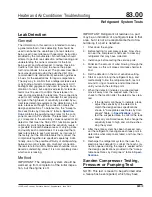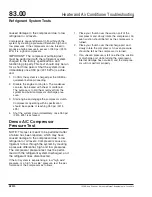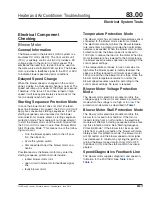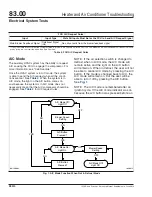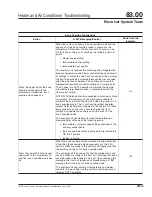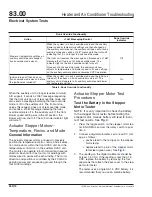
Diagnostic Overview
A/C cooling problems fit into two basic failure catego-
ries: refrigerant or electrical. The goal of this trouble-
shooting guide is to provide the information neces-
sary to determine what part is causing the problem.
We expect the technician to use approved tools and
shop practices, symptom-driven diagnostics, and
warranty component evaluation guides to properly
asses component failures. Refer to
for available tool information, ser-
vice training, and warranty documentation.
For system performance testing, ambient tempera-
ture must be above 70°F (21°C) to produce reliable
results. In order to quickly determine if your symp-
toms are refrigerant or electrical, two main tools
should be utilized by the technician: ServiceLink and
a refrigerant gauge set.
General Diagnostic Procedure
1.
Perform the preliminary checks.
2.
Perform an initial system inspection.
3.
Make a determination about which system is
suspected (refrigerant or electrical), and follow
the symptoms through to a suspected part.
4.
Repair the problem.
5.
Verify that all of the refrigerant connections re-
moved during the service are properly sealed
using an approved refrigerant leak detector.
6.
Verify that the problem has been resolved.
System Overview
The blend air system uses constant discharge tem-
perature control (CDTC) to regulate the temperature
in the vehicle. The CDTC is a closed-loop system
that uses the climate control panel settings and the
temperature sensors to control and maintain the out-
let temperature of the system. The blend air system
has an electronically-controlled, brushless, direct cur-
rent (BLDC) blower motor that does not require a
resistor block to control the blower speed.
In the blend air system, all air is directed through the
evaporator. The amount of air needing to be re-
heated is controlled by the temperature control door,
which directs that amount of air through the heater
core.
The cab HVAC assembly consists of a blower motor,
evaporator, heater core, CDTC sensor, evaporator
temperature sensor, and three electric actuators that
drive the air direction control doors. The doors per-
form the following functions:
•
temperature control door—controls how much
air is directed through or around the heater
core
•
air selection mode door—directs airflow to the
face, floor, or defrost outlets
•
recirculation door—controls the amount of out-
side air that enters the HVAC unit
The cab climate control panel (front control unit) con-
tains the microprocessor that controls the system.
The sleeper or auxiliary HVAC assembly consists of
a brushless blower motor, evaporator, heater core,
auxiliary control unit, air filter, CDTC temperature
sensor, and an electric actuator that drives the tem-
perature control door.
The refrigerant system consists of a compressor,
condenser, receiver-drier, thermal expansion valve(s),
and pressure sensors.
Heater and Air Conditioner Troubleshooting
83.00
General Information
Coronado Workshop Manual, Supplement 5, June 2012
050/1


